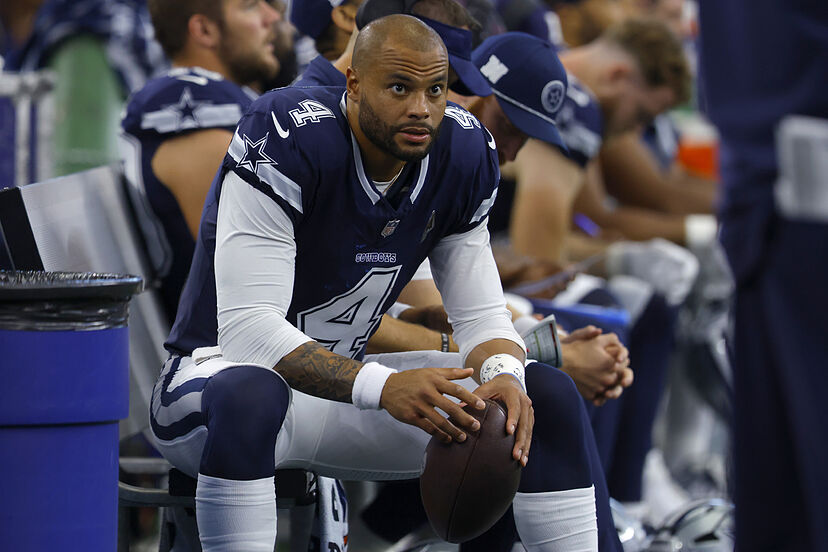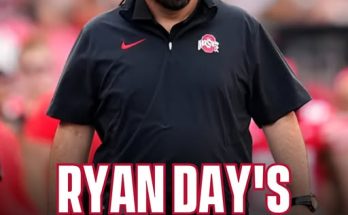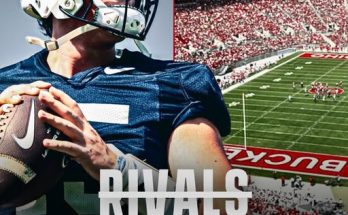Dak Prescott sat alone in the film room of The Star in Frisco, Texas, long after the rest of his teammates had left for the evening. The glow of the projector flickered across his face, but his eyes weren’t focused on the screen anymore. The play had played out. The result—a mistimed throw into double coverage that sealed yet another bitter playoff exit—was nothing new. He’d seen it a hundred times. And yet, the pain never lessened.
The room was quiet, save for the humming fan of the projector and the dull ache in his chest. It wasn’t the physical pain that had nagged him since his devastating ankle injury in 2020 or the shoulder soreness that lingered through training camps. This was different. It was the weight of expectation. The sting of national ridicule. The unrelenting drumbeat of time.
Dak Prescott, the quarterback of the Dallas Cowboys, a man who had once felt invincible wearing the star on his helmet, was now a prisoner of his own legacy. He was tired of the headlines, tired of the memes, tired of being the scapegoat. And so, he turned to something he hadn’t done since college: he wrote.
The letter was never meant to be read by anyone, especially not by Trey Lance.
“Trey, I don’t know if you’ll ever read this…”
It began that way. A quiet confession to a former teammate—though teammate is a generous word. Lance, once the golden child of North Dakota State and a top-three draft pick of the San Francisco 49ers, had been acquired by Dallas for a modest fourth-round pick in 2023. A deal that, at the time, drew shrugs. Lance didn’t play that season, nor the one after. He was a developmental project at best, a reclamation case at worst.
But to Dak, Trey represented something more. Not competition. Not even a threat. But a mirror. A young man whose journey had been shaped by hype, hampered by injuries, and ultimately derailed by the cruel machinery of the NFL. Prescott saw himself not in Lance’s youth, but in his unraveling.
“I see you on the sidelines,” the letter read. “Wearing the headset, clipboard in hand. You remind me of myself back when Romo was still here. Hungry. Watching. Learning. Not knowing if your time will ever come.”
That’s the irony, Dak thought. Everyone believed Lance would challenge him for the starting job. But he never did. He watched, quietly, respectfully, a ghost in the quarterback room.
In Trey’s silence, Dak found something deeply human—someone who had tasted the poison of expectation and still showed up every day.
The Collapse
Dak’s “NFL nightmare” didn’t start with one specific loss, but if you had to pinpoint the moment the tide turned, it would be the January 2022 Wild Card game against the San Francisco 49ers. A disastrous final sequence—an ill-advised scramble and no time to spike the ball—ended the game and ignited a storm of criticism that never quite faded.
Then came 2023. The interceptions piled up. A league-leading 15 picks, many of them soul-crushing momentum killers. The 2024 season saw improvement, statistically speaking. Prescott threw for over 4,500 yards and 33 touchdowns, but again, the Cowboys fell short. A divisional round loss to the Detroit Lions—yes, the Lions—left fans reeling.
The media shredded him. Sports talk shows debated daily whether the Cowboys should move on. Anonymous sources hinted that Jerry Jones had “seen enough.” And even within the locker room, there were whispers. Whispers Dak could feel, even if they were never spoken aloud.
Prescott found himself at war with perception. No matter the numbers, no matter the leadership, he couldn’t shake the growing belief that he wasn’t the guy. That his time had come and gone. That the window was closed.
A Letter Becomes a Lifeline
“I don’t know what you expected, Trey,” Dak wrote. “But I bet it wasn’t this. You came into this league with a cape on your
back. Everyone called you the future. But this league doesn’t wait for the future. It eats it.”
The more Dak wrote, the more his thoughts poured out like therapy on paper. He wasn’t just writing to Trey Lance anymore. He was writing to the version of himself that still believed football was fair. The version of himself that believed hard work and humility would carry him to the mountaintop. The truth, as he was coming to understand, was far more complicated.
“Do you ever think about what life would’ve been like if you were drafted somewhere else?” he asked in the letter. “Someplace quieter. Someplace where one bad throw doesn’t end up on SportsCenter’s Not Top 10?”
He paused.
“I do.”
It wasn’t bitterness—at least, not fully. It was reflection. It was Prescott coming to terms with the burden of being QB1 for the Dallas Cowboys in the 21st century. The contract had brought him generational wealth, yes. But it also handcuffed him to a franchise whose fans, media, and ownership demanded championships—and nothing less.
Brotherhood in the Background
Though they shared the quarterback room, Dak and Trey had rarely spoken in depth. A few words in meetings. Some film study. Occasionally a passing nod at practice. Lance, once a heralded prospect, had settled into a quiet role. He studied the playbook. He lifted with the team. He was respectful, coachable, and patient. And Dak noticed.
“I know they think we’re supposed to hate each other,” Dak wrote. “But I don’t. I respect the hell out of you.”
Lance had every reason to be resentful. Once projected as the future of the 49ers franchise, his time in San Francisco was cut short by injury and the meteoric rise of Brock Purdy. His trade to Dallas had come with no promises, no fanfare. Yet he never complained. Not publicly. Not privately.
That quiet resolve impressed Dak more than he ever let on. It reminded him of his early days, when he sat behind Kellen Moore and Tony Romo, not knowing if his chance would ever come. When Romo got hurt in 2016, Prescott took the reins and never looked back.
He wondered if Trey’s moment might come the same way. And he wondered if he’d be ready to let go when it did.
“I Thought I Could Carry It All”
“I thought I could carry it all—the star, the expectations, the noise,” Dak admitted in the letter. “I thought if I just worked harder, I could lift this franchise back to where it belongs. But maybe I was wrong.”
Those words stung the most.
Prescott had been the ultimate team player since day one. He never blamed others. Never lashed out. He stood at every podium and took every question. He visited every children’s hospital and community center. He was, in every sense, the embodiment of what the Cowboys claimed to want in a franchise quarterback.
But it wasn’t enough.
The playoff record—2-5. The NFC Championship Game appearances—zero. The Super Bowl trips—nonexistent. Every year brought new weapons, new coordinators, new slogans. “This is our year,” they said. But it never was.
Dak Prescott had become a symbol of stagnation. And he was breaking under the weight of it.
The Unspoken Trade Winds
Rumors had swirled heading into the 2025 offseason. Prescott’s contract, with a hefty cap number and no guaranteed money remaining, made him a prime candidate for a trade—or a release. Jerry Jones, as always, kept things vague but provocative.
“We love Dak,” he told reporters at the Combine. “But we also know this is a results-driven business.”
Internally, the Cowboys had begun evaluating other options. The idea of drafting a quarterback wasn’t off the table. Neither was elevating Lance to a true competition. That undercurrent wasn’t lost on Dak.
“I know how this ends,” he wrote to Trey. “Maybe not today. Maybe not this year. But it’s coming. And I’ve made my peace with it.”
But had he?
Writing to Heal
As the pages grew, the tone of the letter shifted. The sadness gave way to wisdom. The doubt gave way to gratitude. And through it all, a theme emerged—hope.
“I don’t know what your future holds,” Dak wrote. “But if you get your shot, make sure you enjoy it. Not just the touchdowns. Enjoy the huddle. The handshake from your center. The way the stadium feels on a Sunday night.”
It was a reminder to himself as much as to Trey. That amid all the pressure and politics, there was still something sacred about the game. Something worth protecting.
Prescott hadn’t lost his love for football. He’d just lost his footing in it.
Trey’s Quiet Response
The letter was never handed over. Not physically. Not directly. But word somehow got to Trey Lance.
One afternoon in March, after a light OTA session, Lance approached Dak at his locker. There was no dramatic monologue. No tears. Just a quiet nod and a simple message.
“Thanks for everything, man. Just so you know, I’ve been watching, too.”
Dak smiled. For the first time in a long time, it felt real.
The Final Season?
As training camp looms, the Cowboys have made no commitments. Prescott remains QB1—for now. But everyone in the building knows 2025 is a fork-in-the-road year for the franchise and its quarterback.
Trey Lance is still QB2, still waiting. But for the first time, the waiting doesn’t feel hopeless. He’s studied. He’s prepared. And if the moment comes, he’ll be ready.
Prescott, meanwhile, is playing with a strange mix of desperation and freedom. The worst has already happened. The criticism can’t cut any deeper. In a way, that makes him dangerous. A quarterback with nothing left to prove—but everything left to give.
Legacy Rewritten
There’s a version of this story where Dak Prescott fades quietly into backup duty, or exits Dallas in search of a final chance elsewhere—maybe in Atlanta, Tampa Bay, or Minnesota. There’s another where he leads the Cowboys on an improbable run, silencing the doubters once and for all.
But there’s also a version where none of that matters. Where his impact is measured not in rings or yards, but in letters never sent, and lessons quietly passed on to the next man up.
Trey Lance may never become a star in the NFL. Or he might. But thanks to Dak Prescott, he’ll walk into that spotlight with a deeper understanding of what it means to wear the star—and to survive beneath it.



